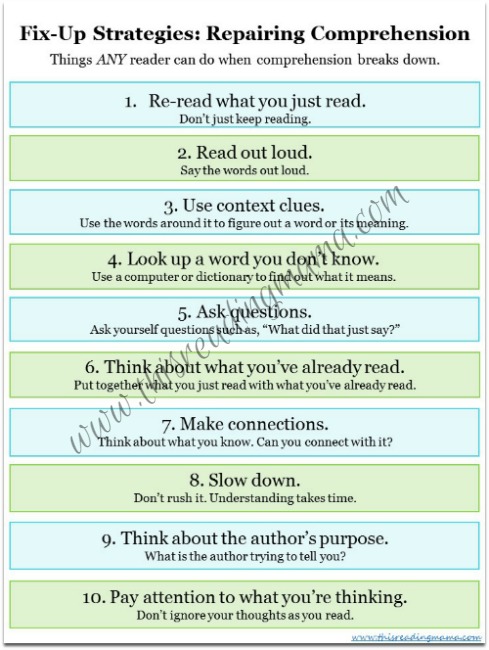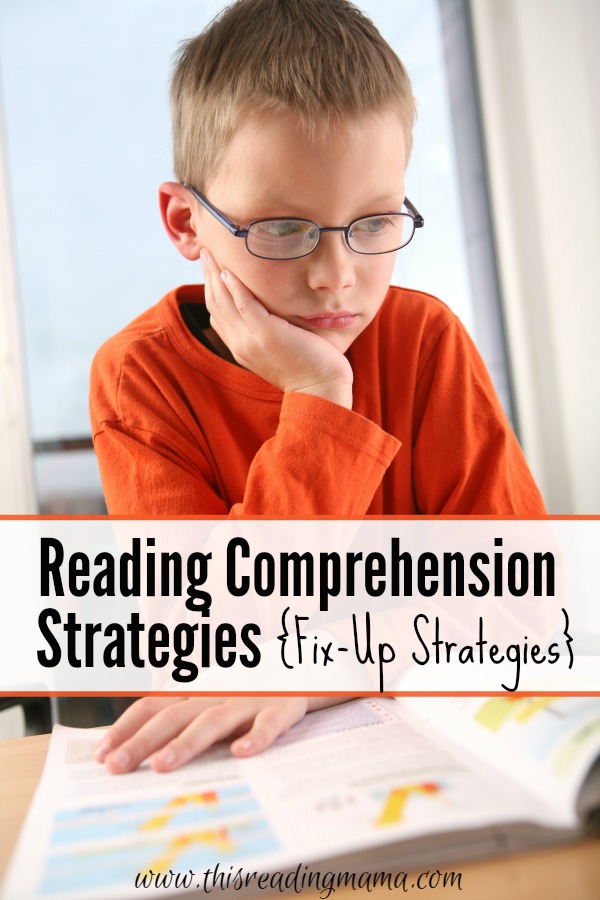If you’ve ever taught a struggling reader alongside a confident reader, you’ll notice some stark differences. While both come to words they don’t know, the confident reader is more likely to try different reading strategies to figure out the unknown words. Often times, the struggling reader freezes because he either doesn’t have the strategies or isn’t sure which one(s) to use.
Both kinds of readers also have times when the text just doesn’t make sense to them. The confident reader is more likely to use reading comprehension strategies {or fix-up strategies} while the struggling reader either freezes or isn’t sure what comprehension strategies to use.
*This post contains affiliate links.
One of the issues for struggling readers is they think that confident or “good” readers don’t need to use these reading comprehension strategies {or fix-up strategies}. Only “bad” readers do. Many times they avoid using them because they feel that using them makes them a “bad” reader (or confirms the fact that they are a “bad” reader). “Good readers”, in their mind, don’t need to use these strategies because “good readers” get it right the first time. What readers, especially struggling readers, need to see is that proficient readers DO use fix-up strategies!
What are Reading Comprehension Strategies {Fix-Up Strategies}?
Have you ever read a passage of text and then realized that while you read every word, you can’t remember a thing? Maybe you misread a word only to find out that the sentence you just read didn’t make a lick of sense. Or perhaps you came across a word that you had never heard of before. Chances are you used a fix-up strategy to help you make sense of what you read. And that’s just what fix-up strategies are. They are reading comprehension strategies that help you “fix up” your understanding (or misunderstandings) as you read.
10 Fix-Up Reading Comprehension Strategies
1. Re-read. This is one that most readers want to skip. “I’ll just keep on reading and she’ll never notice I misread that,” is what a lot of young readers tend to think. But re-reading helps readers to clarify their thoughts or go back and re-read something that was misread to find the mistake and fix it.
2. Read out loud. Sometimes it just helps to hear yourself read out loud. {I personally do this when we buy a new game board and I have no idea what the directions are telling me.}
3. Use context clues. What clues does the picture or sentence(s) surrounding the unknown word offer to help you comprehend? Using context clues can help readers figure out how to decode words or figure out a words meaning. As readers advance, context clues are typically used to figure out how to read words with more than one pronunciation (such as tear or live) or words with more than one meaning (such as run).
4. Look up a word you don’t know. When using context clues still doesn’t help, readers may need to look up the meaning of a word. Words can most certainly be researched on the computer, tablets, or phones {supervised for kids}, but we don’t want to neglect the dictionary. Most readers do not even know how to use a dictionary. Yes, they might be able to look up the word they need, but they also need to be need to be taught how the dictionary lists words by base or root so they can find the definition quickly.
5. Ask questions. Questions such as, “Where did my thinking get off?”, “Does that make sense?”, “What will happen next?” or “What does that word mean?” are quite helpful to the reader.
6. Think about what you’ve already read. Is what you’re now reading fit into the story or purpose of the text?
7. Make connections. Making connections is at the heart of reading comprehension strategies. Readers want to be able to use what they know so it can be connected with what they’re reading. When text doesn’t make sense, good readers may try to make a meaningful connection to make sense of it.
8. Slow down. This another one struggling readers tend to avoid. They want to zoom right past so that no one can draw attention to their mistake. They may also want to just get the reading assignment “done”. Slowing down is the last thing they want to do.
9. Think about the author’s purpose. The author’s purpose for writing dictates the structure they use, the vocabulary they use, and the text features they use. While a reader may be reading the find out more information about a subject, he may discover quickly that the author’s purpose isn’t to share all the arguments, but to persuade the reader only to one side.
10. Pay attention to your own thinking {metacognition}. This may the umbrella that covers all the other fix-up strategies: Proficient readers pay attention to and heed the warnings of the thoughts in their head. When a prediction they make does not pan out as they read, they stop and make new predictions. We must teach readers to think about and be aware of the thoughts in their head as they read.

Download this FREE printable pack. It contains book marks and a 1-page poster (in color and black/white) that you can use to help your readers know that fix-up strategies are a must for every reader!
Modeling Fix-Up Reading Comprehension Strategies
Struggling and reluctant readers need to SEE that proficient readers use these strategies. One SIMPLE way to do this is to model them as we read aloud to kids. We tend to use these naturally without bringing much attention to them. So much so, that a struggling reader may not even realize we’re using them. Instead, we need to slow down and point them out so our kids can see how we use them.
For example, as I was reading The Indian in the Cupboard just recently to my 3rd grader, I came to the word lorry. I honestly had no idea what it meant {UK readers: insert laugh here}. I stopped and said out loud,
- “I wonder what a lorry is?” {strategy #5}
- “I’m going to re-read what I just read to see if I can figure out what lorry means because I’ve never heard it before.” {strategy #1}
- Upon re-reading a little slower this time {strategy #1 and #8}, I was able to say, “Well, I think it’s some kind of vehicle because the word Matchbox is in front of it and we have plenty of Matchbox vehicles. But I’m still not sure what lorry means. I’m going to keep reading a bit more and see if there are any clues.” I finished the paragraph and said, “Nope. I still am not sure of the exact meaning of lorry.” {strategy #3 and #7}
- I was about to pick up my phone and say, “What does lorry mean?” {strategy #4} when my husband, who is a marketing manager in the trucking industry, popped his head into the room and said, “Truck. It means truck.”
- Once I had that info, I said, “Okay. Let me re-read that part again and think ‘truck’ when I read lorry this time.” {strategy #1}
While I don’t do this with every mistake I make at the time it happens during a read aloud {because this could totally interfere with the comprehension and momentum of a read aloud}, I’ll often revisit those places where I re-read or slowed down or listened to my thoughts of “this doesn’t make sense” after we’ve read the book/chapter just to show readers that I STILL use these fix-up reading comprehension strategies. YES, even “good” readers do!
More Ideas for Readers:
- Comprehension Strategies {Reading Equals Thinking}
- Asking Questions to Check Comprehension
- Using Context to Teach Vocabulary {FREE printable}
- 5 Days of Teaching Text Structure {with LOADS of FREE graphic organizers}
- 5 Simple Ways to Improve Reading Comprehension
Follow This Reading Mama’s board Comprehension Strategies on Pinterest.
Follow This Reading Mama’s board Struggling Readers on Pinterest.
~Becky

All strategies very very nice and easy to understand.